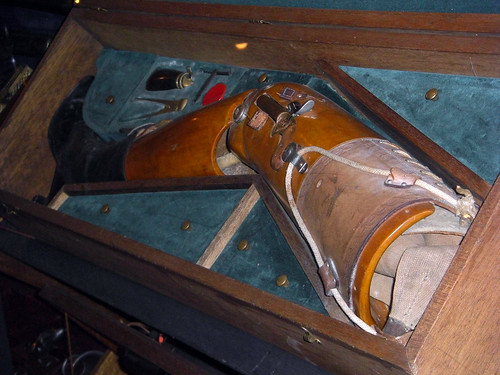On the Streets with a Glitchwired Brain
For decades it's been a basic prediction of bionics that we'll end up with brain implants. Along with robot limbs, these are the flying cars of cyberpunk; the ubiquitous shorthand in science fiction that you are living in the cyborg future. It's also a shortcut to breathless tech-press coverage if you can manage to make the thing you are working on look like a precursor to one. And why not? It's heady stuff.
 photo credit: quinnumsOn the ground, the realities of the only brain-mounted interface I know of – cochlear implants – are brutal. Here's a taste: You can't hear music. For a sense of what that's like, try these demos. The terrifying truth is that once you've signed up for one kind of enhancement (say, the 16 electrode surgery) it's very hard to upgrade, even if Moore's law ends up applying to electrode counts and the fidelity of hearing tech.If you are an early adopter for this kind of thing, the only thing we can say for sure about it is that it'll be slow and out of date very soon. Unless they find a way to make easily-reversible surgery, your best strategy is to wait for the interface that's whatever the brain-linkage equivalent is to 300dpi, full colour, high refresh screens.You'll have to wait. Medical technology advances in fits and starts. When Barney Clark was hooked up to his 400 pound monstrosity of an artificial heart in 1982, things did not go well for him.
photo credit: quinnumsOn the ground, the realities of the only brain-mounted interface I know of – cochlear implants – are brutal. Here's a taste: You can't hear music. For a sense of what that's like, try these demos. The terrifying truth is that once you've signed up for one kind of enhancement (say, the 16 electrode surgery) it's very hard to upgrade, even if Moore's law ends up applying to electrode counts and the fidelity of hearing tech.If you are an early adopter for this kind of thing, the only thing we can say for sure about it is that it'll be slow and out of date very soon. Unless they find a way to make easily-reversible surgery, your best strategy is to wait for the interface that's whatever the brain-linkage equivalent is to 300dpi, full colour, high refresh screens.You'll have to wait. Medical technology advances in fits and starts. When Barney Clark was hooked up to his 400 pound monstrosity of an artificial heart in 1982, things did not go well for him.
During the 112 days that he survived, he underwent four additional operations, had several episodes of bleeding, and experienced prolonged periods of confusion. He even asked to die on several occasions.
The 25th Anniversary of Barney Clark's Artificial Heart![A Heartbreaking Story of Staggering Chin [part 7]](http://farm1.static.flickr.com/77/180607024_e47dac516f.jpg)
 photo credit: centrifuga*teatranteMedical advancements demand sacrifices. Someone needs to wear the interim devices. Desperation is one avenue for adoption. Artificial hearts are still incomplete and dicey-half measures, keeping people alive while they wait for a transplant or their heart heals. This is where advances in transplants and prosthetics find their volunteers and their motivation for progress. It's difficult to envision a therapeutic brain implant – they are almost by definition augmentations.An avenue to irreversible early adoption is arenas where short term enhancement is all that's required. The military leaps to mind. With enlistment times measured in a few short years, rapid obsolescence of implants doesn't matter as much; they can just pull virgin recruits and give them the newest, latest. If this seems unlikely, consider that with the right mix of rhetoric about duty and financial incentives, you can get people to do almost anything including join an organization where they will be professionally shot at.
photo credit: centrifuga*teatranteMedical advancements demand sacrifices. Someone needs to wear the interim devices. Desperation is one avenue for adoption. Artificial hearts are still incomplete and dicey-half measures, keeping people alive while they wait for a transplant or their heart heals. This is where advances in transplants and prosthetics find their volunteers and their motivation for progress. It's difficult to envision a therapeutic brain implant – they are almost by definition augmentations.An avenue to irreversible early adoption is arenas where short term enhancement is all that's required. The military leaps to mind. With enlistment times measured in a few short years, rapid obsolescence of implants doesn't matter as much; they can just pull virgin recruits and give them the newest, latest. If this seems unlikely, consider that with the right mix of rhetoric about duty and financial incentives, you can get people to do almost anything including join an organization where they will be professionally shot at.
 photo credit: DimmerswitchIn his contribution to 50 Cyborgs, Greg Smith points at this possibility.
photo credit: DimmerswitchIn his contribution to 50 Cyborgs, Greg Smith points at this possibility.
Lewis Mumford described the "regimentation and mass-production" of soldiers as delivering a "cheap, standardized and replaceable product" and from the moment a recruit starts basic training, they begin integrating their senses, instincts and bodies into a vast technical apparatus. Projects like FFW and Land Warrior are simply blueprints to further instrumentalize grunts. The above brochure for the latter is quite explicit about this as it reduces soldiers to a kit list – a General Dynamics page goes as far as to list "fratricide avoidance and battery recharging" as equally-weighted selling points – once you move beyond doting over gear and informatics, thinking about these infantry digitization projects can be a little depressing.
Greg Smith cyborg realism: ieds, prosthetic limbs and military r&dWe can envision drone pilots getting these implants as part of the march of progress. Once the tech is friendly enough, it gets sold out to consumers. Meanwhile, you have all these down and out veterans, their brains stuck wired up with old half-working interfaces, begging on the streets for change to pay for a firmware upgrade or a tune-up for their barely-functioning bluetooth legs.